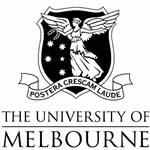 |
620-423 |
Lecturer: Arun Ram, 174 Richard Berry, phone: 8344 6953, email: A.Ram@ms.unimelb.edu.au
Time and Location: Tue 14:15-16:15 Room 2.01 Physics Podium
Subject Outline
Representation Theory is the art of studying complex structures and symmetries by "representing" them as matrices. Viewing the matrices as linear transformations makes the subject into the study of modules. A general representation/module is a large and complex structure like a molecule and is composed of smaller "irreducible components'' which are analogous to atoms. Often, even the "atomic" representations/modules are intricate and the goal of Combinatorial Representation Theory (and this course) is to explore elementary models which allow us to (more) easily determine properties of these representations/modules: size, number of components, splitting and combination rules, and character. The type of models that are the most useful have the flavor of games for children, like legos or erector sets, and yet these models enable one to obtain very explicit information about the fine structure of the corresponding representations, which may have complexities on the order of the microscopic structure of living cells.
Main Topics
- Modules
- "Small" examples: SL2, cyclic and dihedral groups,
- diagram algebras: Temperley-Lieb, the symmetric group, Hecke algebras, and Brauer algebras,
- compact Lie groups, Dynkin diagrams
- characters and character formulas,
- Induction, restriction, and tensor products: branching rules
- loop groups, affine Lie algebras
- connections to statistical mechanics, mathematical physics and geometry.
References
- A. Ram, Dissertation Chapter 1, Unpublished chapter of Ph.D. Thesis
- W. Fulton and J. Harris, Representation theory: a first course, Springer-Verlag 1991 ISBN:0387974954
- R. Slansky article, Group Theory for unified model building, PHYSICS REPORTS(Review Section of Physics Letters) 79, No. 1 (1981) 1—128. North-Holland Publishing Company
Lectures
Lecture 1
- Lecture 1: Handwritten lecture notes
- A. Ram, Dissertation Chapter 1, Unpublished chapter of Ph.D. Thesis
Lecture 2
- Lecture 2: Handwritten lecture notes: The first homework, due in week 5, is on pages 2 and 2.5 of these notes.
- Typed lecture notes from Emily Peters.
- A. Ram, Dissertation Chapter 1, Unpublished chapter of Ph.D. Thesis
- R. Block, The irreducible representations of sl(2) and of the Weyl algebra, Adv. Math 39 (1981), 69-110.
Lecture 3
- Lecture 3: Handwritten lecture notes.
- Typed lecture notes from Emily Peters.
- A. Ram, Dissertation Chapter 1, Unpublished chapter of Ph.D. Thesis
- F. Goodman, P. de la Harpe, and V.F.R. Jones, Coxeter graphs and Towers of Algebras, MSRI publications 14, Springer-Verlag New York, 1989. ISBN 0-387-96979-9.
Lecture 4
-
Lecture 4:
Handwritten lecture notes.
- Typed lecture notes from Emily Peters.
Lecture 5
-
Lecture 5:
Handwritten lecture notes.
- Typed lecture notes from Emily Peters.
Lecture 6
-
Lecture 6:
Handwritten lecture notes.
- Typed lecture notes from Emily Peters.
- Alcove walks, Hecke algebras, Spherical functions, crystals and column strict tableaux, Pure and Applied Mathematics Quarterly 2 no. 4 (Special Issue: In honor of Robert MacPherson, Part 2 of 3) (2006) 963-1013.
Lecture 7
-
Lecture 7:
Handwritten lecture notes.
- Typed lecture notes from Emily Peters.
- Alcove walks, Hecke algebras, Spherical functions, crystals and column strict tableaux, Pure and Applied Mathematics Quarterly 2 no. 4 (Special Issue: In honor of Robert MacPherson, Part 2 of 3) (2006) 963-1013.
Lecture 8
-
Lecture 8:
Handwritten lecture notes.
- Typed lecture notes from Emily Peters.
- Alcove walks, Hecke algebras, Spherical functions, crystals and column strict tableaux, Pure and Applied Mathematics Quarterly 2 no. 4 (Special Issue: In honor of Robert MacPherson, Part 2 of 3) (2006) 963-1013.
Lecture 9
-
Lecture 9:
Handwritten lecture notes.
- Typed lecture notes from Tharatorn Supasiti.
- Lectures on Lie Groups and Lie Algebras, Carter, Segal, and MacDonald, London Math Society Student Texts 32 University of Cambridge Press, 1995.
Lecture 10
-
Lecture 10:
Handwritten lecture notes.
- Class notes taken by Tharatorn Supasiti.
- Lectures on Lie Groups and Lie Algebras, Carter, Segal, and MacDonald, London Math Society Student Texts 32 University of Cambridge Press, 1995.
- Representation Theory, Lecture Notes: Chapter 4, from 2002.
Lecture 11
-
Lecture 11:
Handwritten lecture notes.
- Class notes taken by Tharatorn Supasiti.
- Lectures on Lie Groups and Lie Algebras, Carter, Segal, and MacDonald, London Math Society Student Texts 32 University of Cambridge Press, 1995.
- Representation Theory, Lecture Notes: Chapter 4, from 2002.
Lecture 12
-
Lecture 12:
Handwritten lecture notes.
- Class notes taken by Tharatorn Supasiti.
- Lectures on Lie Groups and Lie Algebras, Carter, Segal, and MacDonald, London Math Society Student Texts 32 University of Cambridge Press, 1995.
- R. Slansky article, Group Theory for unified model building, PHYSICS REPORTS(Review Section of Physics Letters) 79, No. 1 (1981) 1—128. North-Holland Publishing Company.
Assessment
Assessment will be based on two assignments to be handed in during semester (worth 50%) and a final 3-hour exam at the end of semester (worth 50%).
The plaigiarism declaration is available here